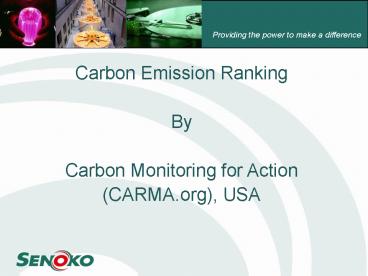Citigate Su Yeang - PowerPoint PPT Presentation
1 / 12
Title:
Citigate Su Yeang
Description:
... market liberalisation started in 2001, the dash for gas has brought steady CO2 ... in CO2 emission intensity, mainly due to dash for gas-fired CCGT generation. ... – PowerPoint PPT presentation
Number of Views:28
Avg rating:3.0/5.0
Title: Citigate Su Yeang
1
Providing the power to make a difference
Carbon Emission Ranking By Carbon Monitoring
for Action (CARMA.org), USA
2
UN Climate Change Conference in Bali
- The delegates at the UN Climate Change Conference
in Bali, which concluded on 15 December 2007 did
not manage to agree on a firm target of CO2
reduction of 2540 by 2020, but they all agreed
that the Bali Roadmap should pave the way for 2
years of negotiations designed to agree a new set
of emissions targets to replace those in the
Kyoto Protocol. - Singapore has limited alternative energy
solutions. Half of CO2 generation in Singapore
comes from power generation. Since the market
liberalisation started in 2001, the dash for gas
has brought steady CO2 reduction from GenCos. - Gas-fired generation is considered as the more
viable large-scale alternative over coal and oil
while the technology of low carbon intensity
energy production is still being developed.
3
Steady increase in Singapore carbon footprint,
1990 - 2004
4
Singapore Key CO2 Contributors
5
CARMA.org (http//www.carma.org/)
- Power generation accounts for 48 of all carbon
emissions in Singapore, 40 in USA and about
one-quarter of global emissions. - Carbon Monitoring for Action (CARMA.org) is a
massive database containing information on carbon
emissions of gt50,000 power plants and 4,000 power
companies worldwide. It is produced and financed
by the Centre for Global Development, an
independent and non-partisan think-tank located
in Washington DC of USA. CARMA.org is the first
global inventory of a major, emissions-producing
sector of the economy. - CARMA draws its information from mandatory
submissions to the Environment Protection Agency
(EPA) by US utilities, official emission reports
from Canada/ European Union/OECD/India, and,
using statistical model calculator based on
plant-level engineering and fuel specifications
for power plants from the rest of the world. - The objective of CARMA.org is to arm individuals
with the information they need to forge a
cleaner, low-carbon future. By revealing the
unvarnished truth regarding both clean and dirty
power producers, CARMA hopes to influence the
opinions and decisions of consumers, investors,
shareholders, managers, workers, activists, and
policymakers.
6
Legends in CARMA website, http//www.carma.org/
- CO2 emission intensity colour codes range from
red to green - gt 1,750 lb/MWh gt 794 kg/MWh
(coal) - 1,2501,750 lb/MWh 567794 kg/MWh (oil)
- 7501,250 lb/MWh 340567 kg/MWh (natural
gas) - 250750 lb/MWh 113340 kg/MWh
- lt 250 lb/MWh lt 113 kg/MWh
(nuclear, hydro) - Original CARMA database of CO2 is expressed in US
ton and lb/MWh - 1 ton (short, US) 2,000 lbs
- 1 lb 0.453592 kg
- 1 TWh 1,000,000 MWh 1x1012 KWh
7
Carbon Dioxide Generated in kg/MWh in Year 2000
and Year 2007
CO2 mm tonnes
Electricity TWh
Source Data from CARMA (www.carma.org)
0.27
Switzerland
5
5
41.54
France
73
74
2007
130.61
218
Canada
2000
253
9.61
233
New Zealand
193
362.80
Japan
355
330
0.53
Macau
489
390
322.89
517
Germany
519
192.28
531
United Kingdom
518
18.68
Singapore
541
777
167.80
South Korea
562
476
138.77
601
Taiwan
619
599.53
606
Russia
434
2,530.53
637
United States
630
55.15
Hong Kong
884
779
528.78
886
India
881
2,430.76
1012
China
855
204.98
1051
Australia
983
0
200
400
600
800
1000
1200
8
Carbon emission by countries
- The worlds top 10 biggest carbon emitters are
USA, China (which is expected to overtake USA by
2008), Russia, India, Japan, Germany, Australia,
South Africa, UK, South Korea. - Australia has the worlds highest CO2 emission
intensity. Next is China. - Rich economies like Switzerland and France with
high ratio of hydro and nuclear facilities are
among the worlds lowest carbon emitters. - France Switzerland
- Annual generation, TWh 565 55.8
- Annual CO2, million tonnes 41.54 0.27
- nuclear 75.9 39.4
- hydro 9.2 55.8
- fossil 11.5 1.1
- other renewable 1.76 0.38
Providing the power to make a difference
9
Carbon Dioxide Generated in kg/MWh in Year 2000
and Year 2007
CO2 mm tonnes 0.02
Electricity TWh
Source Data from CARMA (www.carma.org)
13
Laos
14
18.68
541
Singapore
777
25.85
2007
556
Vietnam
2000
406
32.56
557
Philippines
417
2.61
576
Myanmar
449
0.10
642
Cambodia
792
84.26
749
Indonesia
583
69.29
785
Thailand
705
55.42
799
Malaysia
756
1.33
1054
Brunei
1013
0
200
400
600
800
1000
1200
10
Carbon emission by ASEAN region
- Singapore CO2 emission intensity from power
generation is considered moderate because the
generation is predominantly gas-fired. - Singapore is one of the few countries in the
world to achieve significant reduction in CO2
emission intensity, mainly due to dash for
gas-fired CCGT generation. - Singapore CO2 emission intensity reduction was
30 between 2000 and 2007. It has the best
reduction rate among the only three countries in
the ASEAN region and the only one with 100
electrification to the population. - Except Singapore, Cambodia and Laos, the rest of
ASEAN countries saw their total CO2 intensity
grow in tandem with their economies.
Providing the power to make a difference
11
Carbon Dioxide Generated in kg/MWh in Year 2000
and Year 2007
Source Data from CARMA (www.carma.org)
ElectricityTWh
CO2 milliontonnes/MWh
1.68
0.80
478
SEMBCORP SAKRA
10.30
4.96
2007
0
2000
481
SENOKO
797
9.68
5.35
553
TUAS
773
10.60
6.34
601
PULAU SERAYA
774
0
100
200
300
400
500
600
700
800
Dirty Clean
12
Carbon emission by Singapore GenCo
- Senoko is the best performer in terms of CO2
intensity reduction, by almost 40 between 2000
and 2007. - Senokos CO2 emissions was the lowest among the
three Temasek GenCos.
Providing the power to make a difference




























